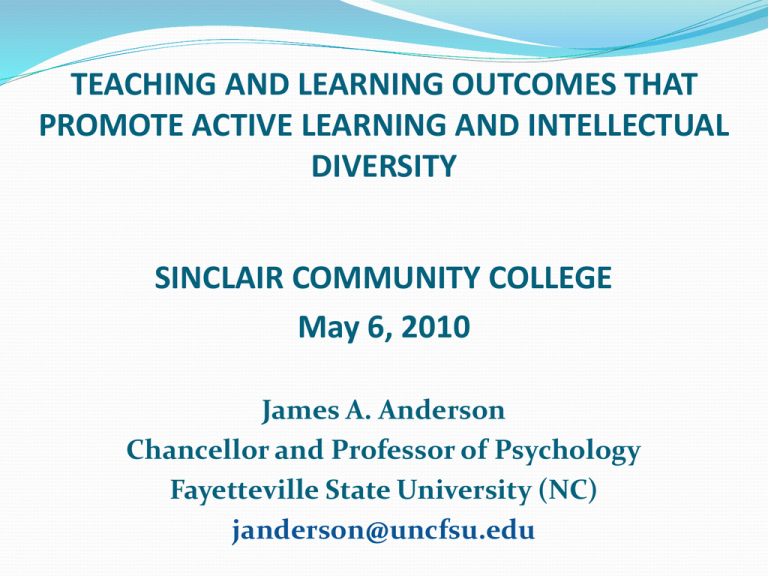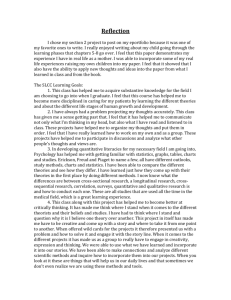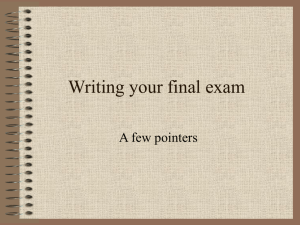What Does it Mean to Discuss Diversity as a
advertisement

TEACHING AND LEARNING OUTCOMES THAT PROMOTE ACTIVE LEARNING AND INTELLECTUAL DIVERSITY SINCLAIR COMMUNITY COLLEGE May 6, 2010 James A. Anderson Chancellor and Professor of Psychology Fayetteville State University (NC) janderson@uncfsu.edu What Do We Know About the Global Preparedness of Pre-9/11 College Graduates Less than 10% of college graduates are globally prepared in terms of knowledge and skills Less than 25% of employers report that college grads are prepared for the global workforce 6% of college seniors are proficient in critical thinking, 77% are NOT proficient Less than 11% of college seniors are proficient at level 3 writing and math What Does it Mean to Discuss Diversity as a Scholarly Activity? Must be intellectually compelling and conceptually sound Incorporate research as a frame of reference Develop an assessment plan Generate a culture of evidence (Direct and Indirect) Present results for public scrutiny Promote organizational change and innovation SINCLAIR CC: DIVERSITY GOAL # 8 Develop and Maintain a Culturally Competent Faculty, Staff, and Student Body 1. What happened to objectives/outcomes? 2. Activities should evolve from objectives/outcomes not a general goal. 3. Are performance measures appropriate and challenging? 4. Shouldn’t faculty be a primary assignment group? 5. Do your selected data sources help you to a) answer critical questions, b) make informed decisions, c) provide evidence that your selected activities were appropriate? Questions That May Help You Recast Your Service or Delivery Systems What are the thinking tasks, intellectual experiences, and/or co-curricular experiences that need to be designed relative to the preparation level and diversity of the students at your institution? What structures need to evolve to assure that students have the opportunity to enhance their academic self-concept and understand their role in the culture of learning at your institution? What data sets do I need to access to generate the appropriate questions and answers about student engagement and student learning? Teaching for Retention and Diversity/Globalism Outcomes Specify outcomes (cognitive, skill-based, disciplinary, program-based, grade-related, etc.) Instructional and pedagogical considerations Academic and co-curricular supports (service-learning, institutes/centers, residential life, community service, etc.) Technology considerations Faculty development/support What does a diversity-centered model of speech-language service delivery involve CLIENTS 1. Acknowledge the realities of language, cultural differences and socioeconomic status 2. Acknowledge unique problems of communicatively impaired minority elderly 3. Utilize natural support systems of families and kinship groups 4. Don’t mistake communicative differences for disorders 5. Acknowledge the importance of context as well as language context and form PROGRAMS 1. Revamping curriculum to include issues of culture, diversity, ethics, gerontology, etc. 2. Mandatory practicum's that expose students to diverse environments 3. Development of academic and training materials that realistically portray needs of diverse patients 4. Increase recruitment and retention of people of color at all levels 5. Include training on disorders associated with bilingual and dual language clients Questions that Promote Critical Discourse About Diversity What must we know and understand about the multiplicity of groups and people that have been unequally acknowledged in our nation? What democratic concepts can we draw on from our own U. S. history to guide us in forging new civic covenants among our citizens? How are we to understand the contradictory interconnections between democratic aspirations and structural injustice? Questions that Promote Critical Discourse About Diversity (cont.) What kinds of intercultural competencies will graduates need to negotiate their disparate and multiple commitments and communities, inherited and adopted? What kinds of knowledge and capabilities are required for full participation in a pluralistic democracy? What kind of values? What are the crucial distinctions between acknowledging difference and learning to take grounded stands in the face of difference? If both are goals for liberal learning, how can we help students develop both kinds of capabilities over time? ROLE OF CRITICAL DIALOGUE GROUPS Sample questions: 1. Compare and contrast the social change strategies of Dr. Martin Luther King Jr. and Osama Bin Laden as tools that liberate disenfranchised groups. Outcomes: 1. Students listen to each other with an analytical ear. 2. Reduction in tension that follows students’ discussion of volatile topics. 3. Students identify the complexity of the issues to be addressed. 4. Students recognize the social/political and interdisciplinary nature of the issue. Offer an example of how cultural differences affect the perceptions of major constructs in the discipline? Educational Psychology Child Psychology - Piaget Counseling Psychology – Racial Identity and Self-Esteem Development How did this account for a cultural perceptions critique of a universally held principle in the discipline? Educational Psychology Child Psychology Counseling Psychology Program Outcomes – Department of History, North Carolina State University HISTORICAL AWARNESS -Graduates of the program should be able to appreciate the varieties of cultural experience in history HISTORICAL RESEARCH SKILLS -Graduates of the program should understand the nature of historical interpretation, the variety of historical sources, and the structure of historical argument HISTORICAL EXPRESSION -Graduates should be able to demonstrate that they are informed and critical consumers and producers of history Purpose of curriculum expansion (Across Gender-Race-Culture-Class) Expand content/scholarship Expand and clarify our view of the world Connect social categories Connect disciplines Destandardize the notion that the universal baseline for experiences, interests, and characteristics is white and male Create a new perspective from which we can make judgments Historicize and politicize Examine the overlap of the fundamental questions raised across dimensions Move away from dichotomous and oppositional framing of one dimension (man/woman, rich/poor) Recenter groups with different social positions during a historical time period or event CURRICULUM CONTENT 1. 2. 3. Historical background of American diversity and the history of key groups (women, African-American, others?) Describing the diversity of American society: - views of diversity in American society - social, cultural, demographic - religion (an ideology) - economic status and patterns - political power, policy, and empowerment strategies - cultural expression (literature, the arts) Diversity-related challenges facing our society: - economic: diversity in the workplace - social, cultural: attitudes, social separation, interpersonal strain, multiculturalism - political: policy, political change and empowerment ALCOA Project Course: Introductory Physical Chemistry (CH 331) Dr. Laura Sremaniak & Ms. Sheila Maness Objectives − Cultivating the cognitive and affective domains − Creating an awareness of student responsibility to learning − Incorporating a historical context to course material − Bringing abstract ideas into an understanding format − Utilizing case studies to establish relevance to students’ disciplinary interests Strategies for Implementation Physical Chemistry (CH 331) 1. Alter instructional strategies to target different learning styles (enhance development of cognitive domain). 2. Pre-mid-post surveys to gauge progress in affective domain. 3. Individual course contracts a) b) c) Emphasizes student responsibility for learning Highlights student ownership of the course Student designs his or her own grading scheme Strategies for Implementation Physical Chemistry (CH 331) cont. 4. A self-written course-pack that includes writing assignments. Students encouraged to incorporate historical context. 5. Exams, quizzes, and group problem assignments emphasize understanding abstract ideas and recognizing assumptions. 6. Case studies introduced at relevant points during the course. Learning outcome statement: to utilize reflection as a strategy that encourages students to make connections between traditional course content in the disciplines and the inclusion of diversity/globalism outcomes. Questions that faculty might consider: 1. What instructional strategies associated with reflection (reflective thinking) do I want to utilize? 2. What new knowledge or competencies should emerge from the “connections” that students make? 3. Should I incorporate writing experiences and, if so, which ones are appropriate? 4. Which area of traditional content offers the most fertile ground to incorporate diversity/globalism outcomes? 5. Should I incorporate moral/ethical considerations and/or examples that are relevant to the student experience? 6. Should students be allowed to utilize their personal/subjective experiences to facilitate the “connections?” 7. What pedagogical tool will best accomplish this? 8. What is the proper balance in the course between traditional and nontraditional scholarship? 9. What are the ground rules that will help students negotiate ambiguity or controversy? 10. To what degree should I as the instructor allow an inclusive curriculum to historicize or politicize traditional course content? Religious Literacy What do graduates need to know about religion in a diverse democracy and global society? (Competencies) How well are we educating students for a religiously pluralistic democracy? (Assessment) How can campus activities address religious insights without promoting or denigrating specific religious beliefs? (Structures) What is the responsibility of your institution to enable students to search for purpose meaning, and a spiritual context or foundation? (Accountability) Raise the Level of Sophistication on Campus of the Discourse About Moral/Religious Issues Cloning Physician-assisted suicide Spousal rights and life support Rights of non-resident immigrant groups Substance abuse and individual responsibility Free speech vs. incivility/tolerance War vs. citizens as collateral damage MOVING FROM THEORY TO RELEVANCY AND PRACTICAL APPLICATION – LaGuardia C.C. (NY) 1. 2. 3. 4. 5. All students engage in cooperative learning experiences. Connects them to diverse communities and diversityrelated outcomes. Allows them to learn how systems function. Expects them to be active participants. Asks them to think critically and reflectively about their experience.





